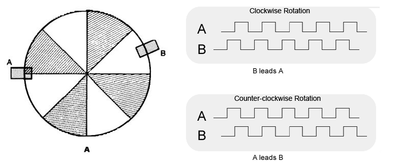Difference between revisions of "Quadrature"
| [checked revision] | [checked revision] |
(→Encoder PPR, CPR, LPR and resolution) |
(→Encoder PPR, CPR, LPR and resolution) |
||
| Line 6: | Line 6: | ||
Most optical encoder specify their resolution as pulses per revolution (PPR) which will equal 4X amount of position values per revolution. I.e. 1000 PPR encoder will yield resolution of 4000 counts per revolution. | Most optical encoder specify their resolution as pulses per revolution (PPR) which will equal 4X amount of position values per revolution. I.e. 1000 PPR encoder will yield resolution of 4000 counts per revolution. | ||
==Encoder PPR, CPR, LPR and resolution== | ==Encoder PPR, CPR, LPR and resolution== | ||
| − | [[File:QuadratureEncoder.png|thumb|Basic principle of quadrature encoder which produces quadrature signals when code wheel rotates and detection light passes through segments at different phase. The encoder in the picture has 4 lines per revolution (LPR) thus it's resolution after 4X decoding is 16 counts per revolution.]] | + | [[File:QuadratureEncoder.png|thumb|400px|Basic principle of quadrature encoder which produces quadrature signals when code wheel rotates and detection light passes through segments at different phase. The encoder in the picture has 4 lines per revolution (LPR) thus it's resolution after 4X decoding is 16 counts per revolution.]] |
Most encoder suppliers specify quadrature encoder resolution as PPR (pulses per revolution) or LPR (lines per revolution). This specifies how many electrical pulses (0 to 1 transitions) there will be during one revolution. Some manufacturers (such as Avago and USdigital) uses name CPR (counts per revolution) to specify pulses per revolution which may seem counter-intuitive. | Most encoder suppliers specify quadrature encoder resolution as PPR (pulses per revolution) or LPR (lines per revolution). This specifies how many electrical pulses (0 to 1 transitions) there will be during one revolution. Some manufacturers (such as Avago and USdigital) uses name CPR (counts per revolution) to specify pulses per revolution which may seem counter-intuitive. | ||
Latest revision as of 23:52, 2 May 2014
Quadrature digital signals consists two channels (wires) and it can carry incremental setpoint or feedback signal. Quadrature signal is commonly seen in optical encoders which is probably the most common feedback device type in modern servo motors. Quadrature signal can be also used as setpoint signal and it has similar properties with pulse and direction.
Contents
Operation[edit | edit source]
Each edge of signal (from A or B channel) will increment or decrement quadrature counter value by one.
Most optical encoder specify their resolution as pulses per revolution (PPR) which will equal 4X amount of position values per revolution. I.e. 1000 PPR encoder will yield resolution of 4000 counts per revolution.
Encoder PPR, CPR, LPR and resolution[edit | edit source]
Most encoder suppliers specify quadrature encoder resolution as PPR (pulses per revolution) or LPR (lines per revolution). This specifies how many electrical pulses (0 to 1 transitions) there will be during one revolution. Some manufacturers (such as Avago and USdigital) uses name CPR (counts per revolution) to specify pulses per revolution which may seem counter-intuitive.
As each pulse will contain two edges (rising and falling) and there are two pulse channels (A and B) with 90 degree phase shift, the total amount of edges will be four times the number of PPR. Most quadrature receivers use so called 4X decoding to count all edges from encoder A and B channels yielding 4X resolution compared to raw PPR value.
Glossary[edit | edit source]
- PPR, P/R, sometimes notated as C/T
- Pulses per revolution
- LPR, L/R
- Lines per revolution (same as PPR)
- CPR
- Counts per revolution. Usually means encoder resolution after 4X decoding. However, some manufacturers (such as Avago and USdigital) specify PPR value as CPR.
An example encoder presented in different ways[edit | edit source]
| Lines or pulses per revolution / LPR or PPR | 2000 |
| Counts per revolution / CPR | 8000 |
| Actual position control resolution | 8000 steps per revolution |
| Mechanical servo accuracy including tracking error | Theoretically 1/8000. In typical case this would yield 1/500 to 1/2000 mechanical accuracy in dynamic conditions (not standing still). |

